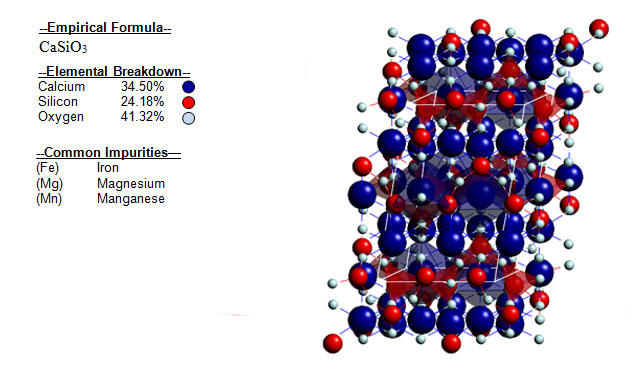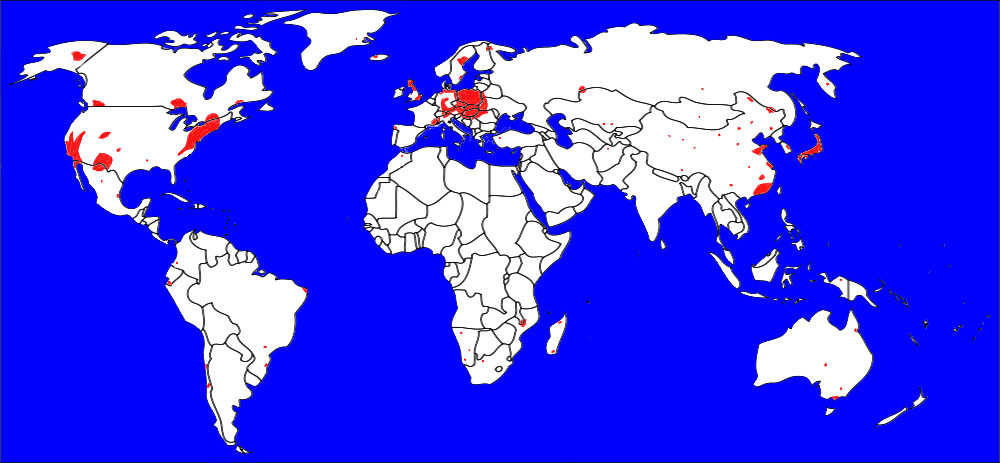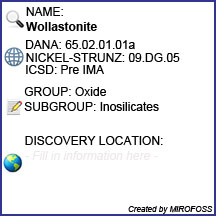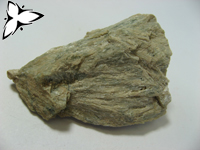![]()
Wollastonite is a calcium inosilicate mineral which is usually white. It is named after the English chemist and mineralogist William Hyde Wollaston (1766–1828). Some of the properties that make wollastonite so useful are its high brightness and whiteness, low moisture and oil absorption, and low volatile content. The major countries which produce wollastonite are China, India, United States, Mexico, and Finland. Finland has long been a major European supplier of wollastonite, but in 2003 it was joined by Spain with comparable production volumes. In the United States, wollastonite is mined in Willsboro, New York and Gouverneur, New York. Deposits have also been mined commercially in North Western Mexico.
 |
Wollastonite is named after William Hyde Wollaston (1766-1828), an English chemist and mineralogist who discovered palladium (1804) and rhodium (1809) and invented the reflecting goniometer (1809) and the camera lucida (1812). |
![]()
Within the metaphysical realm of minerals, wollastonite gives the user moderation and grounding of the their bones and glands.
Please note that MIROFOSS does not suggest in any way that minerals should be used in place of proper medical and psychological care. This information is provided here as a reference only.
![]() Wollastonite is used primarily in ceramics, friction products (brakes and clutches), metal making, paint filler, and plastics.
Wollastonite is used primarily in ceramics, friction products (brakes and clutches), metal making, paint filler, and plastics.
![]()
Wollastonite is usually found in thermally metamorphosed siliceous carbonates, in the igneous rocks and as a skarn deposit.
![]()
Wollastonite forms when impure limestone or dolostone is subjected to high temperature and pressure sometimes in the presence of silica-bearing fluids as in skarns or contact metamorphic rocks. Wollastonite may contain small amounts of iron, magnesium, and manganese substituting for calcium. Associated minerals include garnets, vesuvianite, diopside, tremolite, epidote, plagioclase feldspar, pyroxene and calcite. Wollastonite occurs as bladed crystal masses and single crystals that can show an acicular particle shape and usually it exhibits a white color, but sometimes cream, gray or very pale green.
Other than in the basic mineral form, wollastonite can be found in two distinct varieties:
![]()
| Cleavage | Perfect, Good | |
| Colour(s) | White, Yellow, Gray, Red, Brown | |
| Specific Gravity | 2.84 | |
| Diaphaneity | Subtransparent to Translucent | |
| Fracture | Splintery - Thin, elongated fractures produced by intersecting good cleavages or partings | |
| Mohs Hardness | 5.0 | |
| Luminescence | Non-fluorescent | |
| Lustre | Vitreous to Silky | |
| Streak | White | |
| Habit(s) | Massive fibrous to Radial | |
| Radioactivity | Non-radioactive | |
| Magnetism | Non-magnetic | |
| Electrical | Non-Electric |
![]()
No known health risks have been associated with wollastonite. However ingestion of wollastonite, as with other naturally occurring minerals, is not recommended.
![]()
The following image shows the Elemental breakdown of the mineral wollastonite along with the mineral crystal structure.

![]()
| Crystal System | Triclinic |  |
| Class | Pinacoidal | |
| Axial Ratios | a : b : c = 1.0846 : 1 : 0.9658 | |
| Morphology | Tabular, short or long prismatic. Commonly fibrous, compact, massive. | |
| Optical Data Type | Biaxial (-) | |
| Pleochroism (x) | ||
| Pleochroism (y) | ||
| RL Values | nα = 1.616 - 1.640 nβ = 1.628 - 1.650 nγ = 1.631 - 1.653 |  |
| 2V | Measured: 36° to 60° | |
| Max Birefringence | δ = 0.015 (See colour chart at right) | |
| Surface Relief | Moderate | |
| Dispersion | Weak r > v | |
![]()
Wollastonite can be referenced in certain current and historical texts under the following twelve names:
The mineral wollastonite can be translated into the following select languages:
| Arabic | الولاستونيت | Bulgarian | волостонит | Chinese (Sim) | 硅灰石 |
| Croatian | volastonit | Czech | wollastonitového | Danish | |
| Dutch | wollastoniet | Esperanto | Estonian | ||
| Finnish | wollastoniitti | French | German | Ädelforsit (nach Erdmann) | |
| Greek | βολλαστονίτη | Hebrew | Hungarian | wollastonitos | |
| Italian | Japanese | 珪灰石 | Korean | 규회석 | |
| Latin | Lithuanian | Norwegian | |||
| Persian | ولاستونیت | Polish | wollastonit | Portuguese | |
| Romanian | Russian | Волластонит | Slovak | wollastonitového | |
| Spanish | Grammita | Swedish | wollastonit | Tagalog | |
| Turkish | wollastonite'in | Ukrainian | волластонита | Vietnamese |
![]()
Wollastonite can be found in many places around the world. The map below shows major documented concentrations of wollastonite:
.
![]()
 |
The MIROFOSS database offers free printable geological identification tags for personal and non-profit use. These tags can be used to properly identify mineral samples in your collection. -Click here- to download a full size jpeg image for a wollastonite identification tag; which can be printed on paper or used with a plastic laser printer. |
 |
What's this? What can I do with it? |
![]()
| Chemical Composition | Rustein, M.S. (1971) Re-examination of the wollastonite-hedenbergite (CaSiO3-CaFeSi2O6) equilibria. American Mineralogist: 56: 2040-2052. |
| Crystallography | Ohashi, Y. and Finger, L.W. (1978) The role of octahedral cations in pyroxenoid crystal chemistry. I. Bustamite, wollastonite, and the pectolite-schizolite-serandite series. American Mineralogist: 63: 274-288. |
| Crystallography | Wenk, H.R. (1969) Polymorphism of wollastonite. Contributions to Mineralogy and Petrology: 22: 238-247. |
| History | Peacock, Martin Alfred (1935), On wollastonite and parawollastonite American Journal of Science, 5th. series: 30: 495-529. |
| History | American Mineralogist (1979): 64: 658. |
| History | Richet, P. and Bottinga, Y. (1984b) Anorthite, andesine, wollastonite, dopside, cordierite, and pyrope thermodynamics of melting, glass transitions, and properties of the amorphous phases. Earth and Planetary Science Letters: 67: 415-432. |
| Geographical Data | Mindat.org. Retrieved on 2012-04-26 |
| Physical Identification | Webmineral.com. Retrieved on 2012-04-26. |
| April 26, 2012 | The last time this page was updated |
| ©2017 MIROFOSS™ Foundation | |
 |
|







